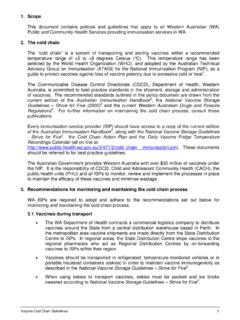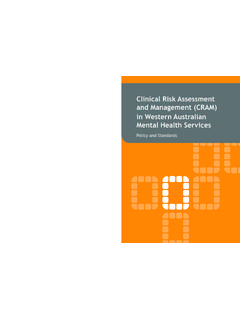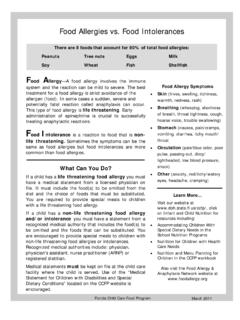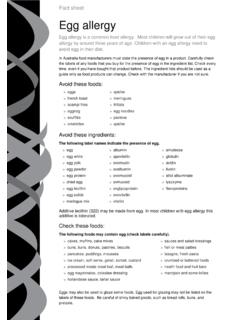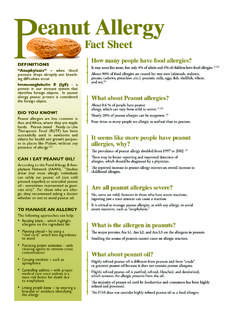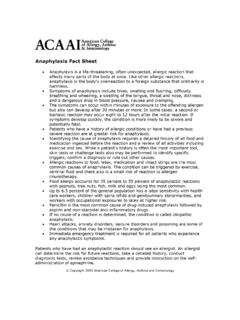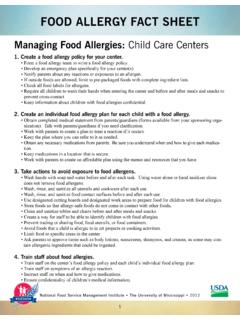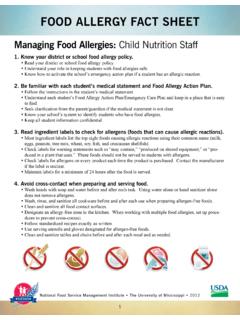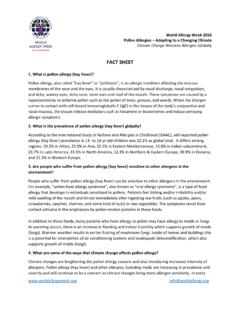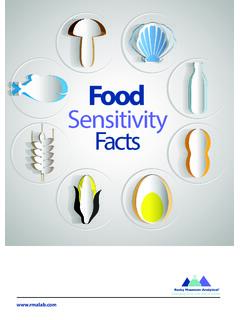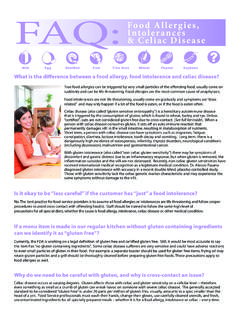Transcription of What is anaphylaxis? What are the signs and - WA Health
1 fact SheetAnaphylaxisAnaphylaxisWhat are allergies?An allergy is when the immune system reacts to substances (allergens) in the environment which are usually harmless ( food proteins, pollen, dust mites). what is anaphylaxis ? anaphylaxis is a severe, often rapidly progressive allergic reaction that is potentially life threatening. what causes anaphylaxis ? anaphylaxis is most commonly caused by food allergies. Any food can cause an allergic reaction, however nine foods cause 90% of reactions in Australia, these are: peanuts tree nuts ( hazelnuts, cashews, almonds) egg cow s milk wheat soybean fish shellfish sesame. Other causes of anaphylaxis include: insect stings and bites medications are the signs and symptoms?
2 Symptoms of a mild to moderate allergic reaction include: swelling of the lips, face and eyes hives or welts tingling mouth abdominal pain or vomiting (these are signs of severe allergic reaction to insects). Symptoms of anaphylaxis (severe allergic reaction) watch for any one of the following: difficulty or noisy breathing swelling of the tongue swelling/tightness in the throat difficulty talking and/or a hoarse voice wheezing or persistent cough loss of consciousness and/or collapse young children may appear pale and SheetAnaphylaxisWhy is it important to know about anaphylaxis ?Avoidance of known allergens is crucial in the management of anaphylaxis . Schools and child care services need to work with parents/guardians and children to minimise a child s exposure to known allergens.
3 Knowledge of severe allergies will assist staff to better understand how to help children who are at risk of can anaphylaxis be treated?Adrenaline given as an injection using an autoinjector (such as an EpiPen or Anapen ) into the outer mid thigh muscle is the most effective first aid treatment for anaphylaxis . Adrenaline autoinjectors are designed so that anyone can use them in an should provide schools or child care services with an adrenaline autoinjector and ASCIA Action Plan for their child, which should be stored unlocked and easily accessible to staff. If a child is treated with an adrenaline autoinjector, an ambulance must be called immediately to take the child to a can anaphylaxis be prevented?
4 The key to the prevention of anaphylaxis is: knowledge of children who are at risk, awareness of known allergens, and prevention of exposure to known children wear a medical warning bracelet to indicate management in schools or child care servicesWhen a child known to be at risk of anaphylaxis attends a school or child care service, parents/guardians must: inform staff of the child s allergies discuss risk minimisation strategies with staff work with staff to complete an Individual anaphylaxis Health Care Plan provide the school with a copy of the child s ASCIA Action Plan that has been completed by a medical practitioner and has an up-to-date photograph supply the child s adrenaline autoinjector and ensure it has not expiredIt is recommended that staff involved.
5 Know the identity of children who are at risk of anaphylaxis communicate regularly with parents/guardians follow information contained in the child s Individual anaphylaxis Health Care Plan obtain training in how to recognise and respond to an anaphylactic reaction, including administering an adrenaline autoinjector ensure the adrenaline autoinjector is stored in an unlocked, easily accessible place know where the adrenaline autoinjector is located in the event of a reaction, follow the procedures in the child s ASCIA Action Plan Further information:WA Department of Health Society of Clinical Immunology and allergy (ASCIA) Australia SEP 10 SK7
